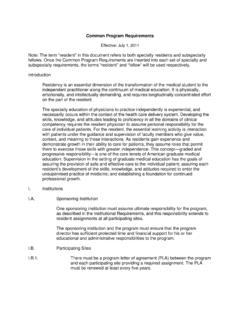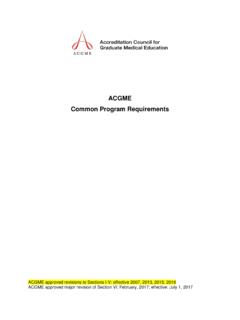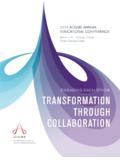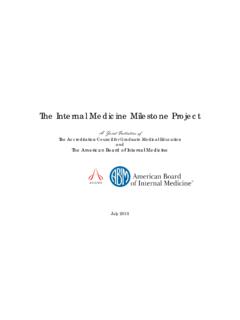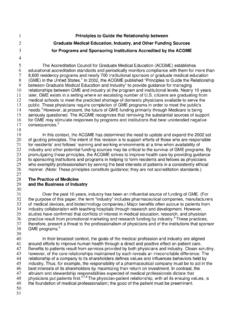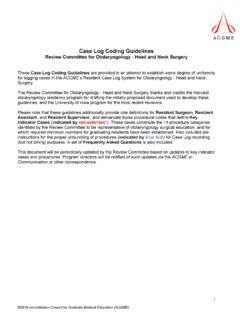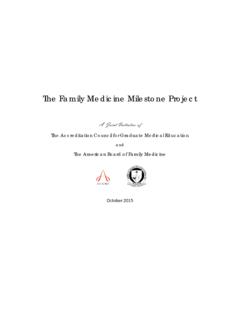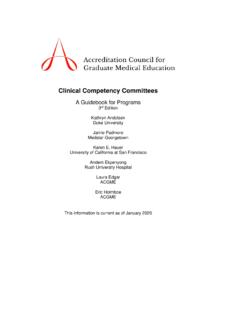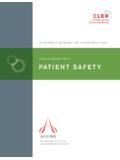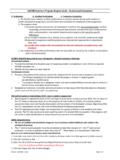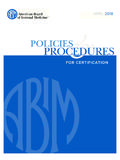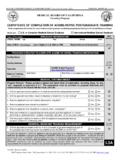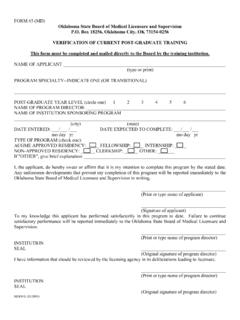Transcription of Milestones Guidebook for Residents and Fellows - …
1 2017 accreditation council for graduate medical education ( acgme ) Milestones Guidebook for Residents and Fellows June 2017 Dinchen Jardine, MD Jessica Deslauriers, MD Sophia C. Kamran, MD Nickalus Khan, MD Stanley Hamstra, PhD Laura Edgar, EdD 2017 accreditation council for graduate medical education ( acgme ) Table of Contents Topic Page(s) Introduction .. 1 Summary Recommendations for Residents and Fellows .. 2 Competency-Based medical education .. 3-4 Milestones The 5 Ws .. 5-6 Assessment for Residents and Fellows .. 7-8 resident /Fellow Feedback .. 9-12 milestone Reports Available in ADS .. 13 Other Resources .. 14 1 2017 accreditation council for graduate medical education ( acgme ) INTRODUCTION Welcome to the first edition of the Milestones Guidebook for Residents and Fellows !
2 The Next accreditation System (NAS), launched in 2013 and now fully implemented for all acgme -accredited institutions and programs in all specialties, brings the concept of a continuous improvement process to graduate medical education . The Milestones , which this Guidebook explains, provide specific competency descriptions for each progressive step along the developmental pathway within a specialty or subspecialty of medicine. They are a fundamental component of the NAS, and understanding them can help you develop your own curricular pathways in order to reach your own personal professional goals. This Guidebook was written by the resident and fellow members of the acgme s council of Review Committee Residents (CRCR), based on the Milestones Guidebook for programs, to provide a learner perspective on what the Milestones represent and how they might be used to facilitate progress throughout training.
3 The goal was to give the background and purpose in a succinct format that could be easily understood and referenced by a busy resident or fellow. We hope that understanding the purpose and intent behind the Milestones will help other Residents and Fellows improve their ability to ask for and receive better feedback, will facilitate mentoring and coaching within programs, and will help all Residents and Fellows to progress to becoming the best possible physician. Thank you for taking the time to read this Guidebook and for engaging in the process of improving your own education . We welcome any feedback on this Guidebook or on the Milestones in general. E-mail with feedback or questions. Dink Jardine, MD Chair, acgme council of Review Committee Residents 2015-2017 Acknowledgements: We would like to thank Eric Holmboe, MD and Nicholas Yaghmour, MPP for their guidance and assistance with this project.
4 2 2017 accreditation council for graduate medical education ( acgme ) SUMMARY RECOMMENDATIONS FOR Residents AND Fellows 1. Be sure to review your specialty Milestones on an ongoing basis, especially at the start of each academic year, to deepen your understanding of the Milestones to help in your own professional development. 2. Perform a self-assessment twice a year around the same time your program s Clinical Competency Committee (CCC) meets. 3. Review and compare your self-assessment with the CCC milestone ratings with your program director, faculty advisor, or mentor. 4. Write an individualized learning plan at least twice a year, and discuss it with your program director, faculty advisor, or mentor. 3 2017 accreditation council for graduate medical education ( acgme ) COMPETENCY-BASED medical education (CBME) Competency-based education and/or training has been around since the 1920s in business and industry, and since the 1960s as part of a teacher education reform CBME was first promoted for widespread use in a report to the World Health Organization in 1978.
5 The report stated, The output of a CBME program is a health professional who can practice at a defined level of proficiency to meet local needs. 2 CBME is a foundational element of the NAS. The focus of the NAS is continuous quality improvement and innovation through ,4 What is CBME? CBME measures the progression toward specific competencies (including the knowledge, skills, and attitudes within them). The CBME system promotes progressive development of a competency ( , competence in the care of pediatric neonates). Additionally, CBME allows for longitudinal assessment of the learner and provides feedback, coaching, and adjustments structured to the learning ,6 Table 1 below compares the traditional medical educational model to CBME. Table 1. A comparison of Traditional vs.
6 Competency Based medical education Variable Traditional Educational Model CBME Driving force for curriculum Knowledge acquisition Knowledge application Driving force for process Teacher Learner Path of learning Hierarchal Non-hierarchal Responsibility of content Teacher Teacher and student Goal of educational encounter Knowledge acquisition Knowledge application Type of assessment tool Single assessment measure ( , test) Multiple assessment measures ( , direct observation) Assessment tool Proxy Authentic (mimics real profession) Setting for evaluation Removed In clinical and professional settings Timing of assessment Emphasis on summative Emphasis on formative Program completion Fixed time Variable time Adapted from Carraccio, 20027 4 2017 accreditation council for graduate medical education ( acgme ) How does CBME relate to my medical education ?
7 CBME is based on a core set of six general competencies developed by the acgme and the American Board of medical Specialties (ABMS) in 1999. The Core Competencies are: Patient Care and Procedural Skills medical Knowledge Practice-based Learning and Improvement Interpersonal and Communication Skills Professionalism Systems-based Practice Under the umbrella of each competency area are specialty (or subspecialty)-specific Milestones . Each medical specialty developed its own set of Milestones to guide the learning and assessment of its learners through the Core Competencies. This Milestones system focuses on resident /fellow education and competency (specific to the individual) rather than time served in training. Some important facts that Residents should know about the Milestones Focus on competency and a pathway to expertise Emphasize knowledge application rather than just knowledge acquisition Are specialty-specific Focus more on the learner, and are more individualized ( learner-centric ) Allow for better feedback, coaching, and adjustments to learning plans to ensure all graduates are prepared for unsupervised practice Evaluation reflects a real-world observation and consists of a portfolio of assessment tools References 1.
8 Elam, S., Performance-based teacher education : What is the sate of the art? Retrieved from June 14, 2017 2. McGaghie, W. Competency-based curriculum development in medical education : An introduction. Retrieved from June 14, 20173. Nasca TJ, Philibert I, Brigham T, Flynn TC. The next GME accreditation system--rationale and benefits. The New England journal of medicine. Mar 15 2012;366(11):1051-1056. 4. Weiss KB, Bagian JP, Nasca TJ. The clinical learning environment: the foundation of graduate medical education . JAMA. Apr 24 2013;309(16):1687-1688. 5. Kogan JR, Holmboe E. Realizing the promise and importance of performance-based assessment. Teaching and learning in medicine. 2013;25 Suppl 1:S68-74. 6. Holmboe ES, Sherbino J, Long DM, Swing SR, Frank JR.
9 The role of assessment in competency-based medical education . medical teacher. 2010;32(8):676-682. 7. Carraccio C, Wolfsthal SD, Englander R, Ferentz K, Martin C. Shifting paradigms: from Flexner to competencies. Acad Med. May 2002;77(5):361-367. 5 2017 accreditation council for graduate medical education ( acgme ) Milestones THE 5 Ws Who? Milestones were developed by Working Groups composed of key stakeholders in each specialty. Working Groups included Residents and Fellows , members of the acgme Review Committees, program directors, and representatives of the applicable American Board of medical Specialties board and specialty societies. resident and fellow input has been an integral part of Milestones development. What? Milestones are learning trajectories highlighting significant points in resident and fellow development to assess learner competency in six key areas of medical education : Patient Care; medical Knowledge; Professionalism; Interpersonal and Communication Skills; Practice-based Learning and Improvement; and Systems-based Practice.
10 Milestones sets include five levels of development, ranging from a beginning learner to an aspirational level of development. Level 4, typically designed to represent competency in most but not all specialties, describes the knowledge, skills, or attitudes that a resident or fellow should achieve by the time of graduation. Note that a few specialties have used different titles for the Milestones levels, but the intent is similar. Where? Milestones are utilized by all acgme -accredited programs to provide added guidance to help ensure all graduating Residents and Fellows from these programs have achieved a high level of competence in the six key clinical domains. When? In 2009, the acgme began transitioning to the NAS, a system that incorporated a competency-based medical education model to help produce physicians prepared to practice medicine in the 21st century.
